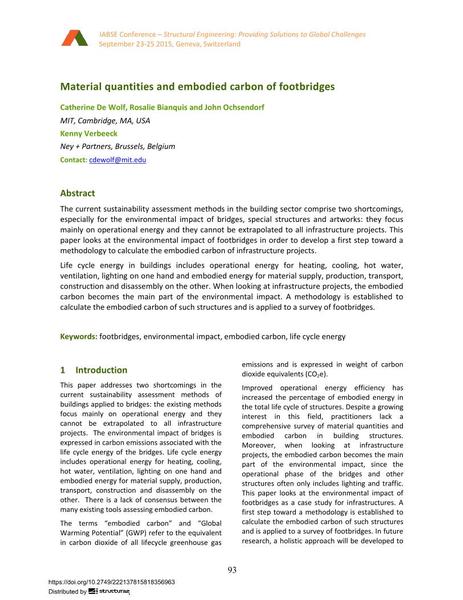Material quantities and embodied carbon of footbridges

|
|
|||||||||||
Bibliografische Angaben
| Autor(en): |
Catherine De Wolf
(MIT, Cambridge, MA, USA)
Rosalie Bianquis (MIT, Cambridge, MA, USA) John Ochsendorf (MIT, Cambridge, MA, USA) Kenny Verbeeck (Ney + Partners, Brussels, Belgium) |
||||
|---|---|---|---|---|---|
| Medium: | Tagungsbeitrag | ||||
| Sprache(n): | Englisch | ||||
| Tagung: | IABSE Conference: Structural Engineering: Providing Solutions to Global Challenges, Geneva, Switzerland, September 2015 | ||||
| Veröffentlicht in: | IABSE Conference Geneva 2015 | ||||
|
|||||
| Seite(n): | 93-100 | ||||
| Anzahl der Seiten (im PDF): | 8 | ||||
| Jahr: | 2015 | ||||
| DOI: | 10.2749/222137815818356963 | ||||
| Abstrakt: |
The current sustainability assessment methods in the building sector comprise two shortcomings, especially for the environmental impact of bridges, special structures and artworks: they focus mainly on operational energy and they cannot be extrapolated to all infrastructure projects. This paper looks at the environmental impact of footbridges in order to develop a first step toward a methodology to calculate the embodied carbon of infrastructure projects. Life cycle energy in buildings includes operational energy for heating, cooling, hot water, ventilation, lighting on one hand and embodied energy for material supply, production, transport, construction and disassembly on the other. When looking at infrastructure projects, the embodied carbon becomes the main part of the environmental impact. A methodology is established to calculate the embodied carbon of such structures and is applied to a survey of footbridges. |
||||
| Stichwörter: |
Umweltbelastung Fußgängerstege Fußgängerbrücken Lebenszyklusenergie
|
||||

